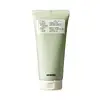What's inside
What's inside
 Key Ingredients
Key Ingredients

 Benefits
Benefits

 Concerns
Concerns

 Ingredients Side-by-side
Ingredients Side-by-side

Montmorillonite
AbsorbentWater 13%
Skin ConditioningGlycerin
HumectantMethyl Perfluoroisobutyl Ether
SolventLauryl Betaine
CleansingDecyl Glucoside
CleansingHydroxypropyl Starch Phosphate
Coco-Glucoside
CleansingMethylpropanediol
SolventSodium Chloride
MaskingHydroxyacetophenone
AntioxidantCitric Acid
BufferingCI 77288
Cosmetic ColorantSand
AbrasiveEthylhexylglycerin
Skin ConditioningHydroxycaprylic Acid
Skin ConditioningDisodium EDTA
Triethoxycaprylylsilane
Ocimum Basilicum Leaf Extract
Skin ConditioningInonotus Obliquus Extract
Skin ConditioningWithania Somnifera Extract
Skin ConditioningGanoderma Lucidum Extract
Skin ProtectingPlumbago Zeylanica Flower/Root Extract
AntioxidantButylene Glycol
HumectantOcimum Basilicum Leaf Powder
TonicGluconolactone
Skin ConditioningOak Root Extract
Skin ConditioningAvena Sativa Kernel Extract
AbrasiveOcimum Basilicum Extract
AntioxidantChamomilla Recutita Extract
Skin ConditioningLavandula Angustifolia Flower Extract
CleansingSepia Extract
Skin ConditioningSalvia Sclarea Extract
AntiseborrhoeicChrysanthemum Indicum Flower Extract
Skin ConditioningBarm Extract
Skin ConditioningCitrus Limon Peel Oil
MaskingMontmorillonite, Water 13%, Glycerin, Methyl Perfluoroisobutyl Ether, Lauryl Betaine, Decyl Glucoside, Hydroxypropyl Starch Phosphate, Coco-Glucoside, Methylpropanediol, Sodium Chloride, Hydroxyacetophenone, Citric Acid, CI 77288, Sand, Ethylhexylglycerin, Hydroxycaprylic Acid, Disodium EDTA, Triethoxycaprylylsilane, Ocimum Basilicum Leaf Extract, Inonotus Obliquus Extract, Withania Somnifera Extract, Ganoderma Lucidum Extract, Plumbago Zeylanica Flower/Root Extract, Butylene Glycol, Ocimum Basilicum Leaf Powder, Gluconolactone, Oak Root Extract, Avena Sativa Kernel Extract, Ocimum Basilicum Extract, Chamomilla Recutita Extract, Lavandula Angustifolia Flower Extract, Sepia Extract, Salvia Sclarea Extract, Chrysanthemum Indicum Flower Extract, Barm Extract, Citrus Limon Peel Oil
Glycerin
HumectantSodium Cocoyl Isethionate
CleansingWater
Skin ConditioningCoconut Acid
CleansingNiacinamide
Smoothing1,2-Hexanediol
Skin ConditioningCetearyl Alcohol
EmollientCoco-Betaine
CleansingMyristic Acid
CleansingSodium Isethionate
CleansingStearic Acid
CleansingArtemisia Caruifolia Powder
AbrasiveCentella Asiatica Extract
CleansingSodium Hyaluronate
HumectantCeramide NP
Skin ConditioningSodium Chloride
MaskingGardenia Florida Fruit Extract
Skin ConditioningDextrin
AbsorbentPropylene Glycol
HumectantButylene Glycol
HumectantPalmitic Acid
EmollientPolyquaternium-67
Sodium Acetate
BufferingHydrogenated Lecithin
EmulsifyingMelaleuca Alternifolia Leaf Oil
AntioxidantPelargonium Graveolens Flower Oil
MaskingRosmarinus Officinalis Leaf Oil
MaskingCitrus Limon Peel Oil
MaskingCitrus Aurantium Dulcis Peel Oil
MaskingLimonene
PerfumingCitral
PerfumingGeraniol
PerfumingLinalool
PerfumingCitronellol
PerfumingGlycerin, Sodium Cocoyl Isethionate, Water, Coconut Acid, Niacinamide, 1,2-Hexanediol, Cetearyl Alcohol, Coco-Betaine, Myristic Acid, Sodium Isethionate, Stearic Acid, Artemisia Caruifolia Powder, Centella Asiatica Extract, Sodium Hyaluronate, Ceramide NP, Sodium Chloride, Gardenia Florida Fruit Extract, Dextrin, Propylene Glycol, Butylene Glycol, Palmitic Acid, Polyquaternium-67, Sodium Acetate, Hydrogenated Lecithin, Melaleuca Alternifolia Leaf Oil, Pelargonium Graveolens Flower Oil, Rosmarinus Officinalis Leaf Oil, Citrus Limon Peel Oil, Citrus Aurantium Dulcis Peel Oil, Limonene, Citral, Geraniol, Linalool, Citronellol
 Reviews
Reviews

Alternatives
Ingredients Explained
These ingredients are found in both products.
Ingredients higher up in an ingredient list are typically present in a larger amount.
Butylene Glycol (or BG) is used within cosmetic products for a few different reasons:
Overall, Butylene Glycol is a safe and well-rounded ingredient that works well with other ingredients.
Though this ingredient works well with most skin types, some people with sensitive skin may experience a reaction such as allergic rashes, closed comedones, or itchiness.
Learn more about Butylene GlycolCitrus Limon Peel Oil is created from the peels of the lemon. It is used to add a lemon-scent to products. Lemon peel oil also has antibacterial, antifungal, and antioxidant properties. However, it may also cause phototoxicity and sensitize skin.
Lemon peel oil contains limonene, a skin sensitizing ingredient. Another component is furanocoumarin, which induces phototoxicity in skin.
Furanocoumarins bind and destabilize your DNA to increase the rate of sunburn.
Most reputable companies will remove furanocoumarins from their formulations.
Learn more about Citrus Limon Peel OilGlycerin is already naturally found in your skin. It helps moisturize and protect your skin.
A study from 2016 found glycerin to be more effective as a humectant than AHAs and hyaluronic acid.
As a humectant, it helps the skin stay hydrated by pulling moisture to your skin. The low molecular weight of glycerin allows it to pull moisture into the deeper layers of your skin.
Hydrated skin improves your skin barrier; Your skin barrier helps protect against irritants and bacteria.
Glycerin has also been found to have antimicrobial and antiviral properties. Due to these properties, glycerin is often used in wound and burn treatments.
In cosmetics, glycerin is usually derived from plants such as soybean or palm. However, it can also be sourced from animals, such as tallow or animal fat.
This ingredient is organic, colorless, odorless, and non-toxic.
Glycerin is the name for this ingredient in American English. British English uses Glycerol/Glycerine.
Learn more about GlycerinChances are, you eat sodium chloride every day. Sodium Chloride is also known as table salt.
This ingredient has many purposes in skincare: thickener, emulsifier, and exfoliator.
You'll most likely find this ingredient in cleansers where it is used to create a gel-like texture. As an emulsifier, it also prevents ingredients from separating.
There is much debate on whether this ingredient is comedogenic. The short answer - comedogenic ratings don't tell the whole story. Learn more about comegodenic ratings here.
The concensus about this ingredient causing acne seems to be divided. Research is needed to understand if this ingredient does cause acne.
Scrubs may use salt as the primary exfoliating ingredient.
Learn more about Sodium ChlorideWater. It's the most common cosmetic ingredient of all. You'll usually see it at the top of ingredient lists, meaning that it makes up the largest part of the product.
So why is it so popular? Water most often acts as a solvent - this means that it helps dissolve other ingredients into the formulation.
You'll also recognize water as that liquid we all need to stay alive. If you see this, drink a glass of water. Stay hydrated!
Learn more about Water